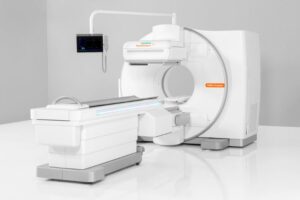
What is Nuclear Medicine Used For?
Have you heard of nuclear medicine?
It’s a revolutionary tool in modern healthcare that offers a unique way to diagnose and treat a number of diseases.
Using small amounts of radioactive tracer, doctors use the technology to examine organs in great detail. It goes beyond the possibilities of standard imaging techniques.
How It Is Revolutionising Disease Diagnosis and Treatment
Nuclear medicine has transformed the way medical professionals detect and manage medical conditions, from heart disease to cancer. It provides crucial insights that lead to more effective treatments.
Want to learn more? Let’s dive in together and explore why nuclear medicine is such an invaluable asset.

Nuclear Medicine in Cancer Diagnosis and Staging
Early Detection
Nuclear medicine helps identify cancer at its earliest stages. By using radiopharmaceuticals that target cancer cells, nuclear medicine scans can reveal the presence of tumours that might not yet be visible when using other imaging methods.
Staging and Extent
Nuclear medicine is critical for staging cancer (determining how far cancer has spread). For example, PET scans show the activity of cancer cells throughout the body. This helps doctors understand the extent of the cancer and the next steps they need to take for effective treatment.
Types of Cancer
There are certain types of cancer where nuclear medicine is invaluable for diagnosing and staging:
- Breast Cancer: Identifies small tumours and checks if the cancer has spread to the lymph nodes.
- Lung Cancer: Assesses lung nodules and detects metastasis to other organs.
- Prostate Cancer: Effective in locating residual cancer post-surgery or detecting recurrence.

Cardiovascular Applications of Nuclear Medicine
Evaluating Heart Function
Nuclear medicine is used to assess how well the heart is pumping blood. A myocardial perfusion scan (also known as a nuclear stress test) shows blood flow to the heart muscle, highlighting areas with poor blood supply.
Detecting Cardiovascular Conditions
Nuclear medicine helps to detect conditions like coronary artery disease. By showing areas of reduced blood flow, it identifies blockages in the heart’s arteries.
Personalised Treatment Plans
The detailed images from nuclear medicine scans allow doctors to create tailored treatment plans for their patients. For instance, based on the scan results, they can determine the need for angioplasty or bypass surgery.

Musculoskeletal and Bone Health Assessment
Detecting Fractures and Injuries
One of nuclear medicine’s superpowers is identifying bone fractures that may not be visible on standard X-rays. A bone scan can detect stress fractures, bone infections, or hidden bone injuries.
Diagnosing Osteoporosis
Nuclear medicine is a big part of diagnosing osteoporosis. It provides detailed images of bone density and structure, which helps to assess the risk of fractures.
Guiding Orthopaedic Treatment
Nuclear medicine plays a vital role in orthopaedic care. The technology helps doctors plan surgeries and other treatments. For example, a bone scan can determine the extent of joint damage before a joint replacement procedure.

Neurological Disorders and Brain Imaging
Studying Brain Activity
Nuclear medicine is used to analyse brain function and metabolism. Scans like PET and SPECT provide detailed images of brain activity, revealing areas with abnormal function.
Diagnosing Neurological Disorders
Nuclear medicine is particularly effective in diagnosing conditions like Alzheimer’s disease and Parkinson’s disease. It helps identify specific patterns of brain activity associated with these disorders.
Assisting in Treatment Planning
Nuclear medicine helps doctors develop targeted treatment strategies for brain-related conditions by showing how different areas of the brain work. For example, it can help evaluate the effectiveness of treatments for epilepsy and other neurological disorders.

Infection Detection and Inflammatory Conditions
Identifying Infections and Inflammation
Nuclear medicine is excellent for detecting infections or inflammation. Doctors use radiopharmaceuticals that accumulate in areas with high metabolic activity. A gallium scan, for example, can highlight inflammatory processes in the body.
Localising the Source
Nuclear medicine is incredibly effective at pinpointing the exact location of an infection. This is crucial for conditions where the source isn’t easily identified through other procedures.
Assessing Treatment Progress
Nuclear medicine also plays a role in monitoring the effectiveness of treatments for injections or inflammatory diseases like arthritis. By comparing scans from before and after the treatment, doctors can assess how well the condition is responding to therapy.

Thyroid Disorders and Endocrine System Assessment
Assessing Thyroid Function
This procedure involves using a small amount of radioactive tracer, typically sodium pertechnetate, which is absorbed by thyroid tissue. A special camera then captures images to assess the organ’s function.
Detecting Abnormalities
This method is crucial in identifying conditions like hyperthyroidism or hypothyroidism. The tracer highlights areas in the thyroid that are functioning abnormally.
Examples of Conditions
Here are some related conditions doctors use nuclear medicine to assess:
- Hyperthyroidism: Nuclear medicine helps to measure the thyroid’s overactivity.
- Thyroid Nodules: Differentiates between overactive and underactive nodules (hyper and hypo nodules).
- Hypothyroidism: Nuclear medicine detects a thyroid that is underactive.

Wrapping Up: The Broad Spectrum of Nuclear Medicine
Key Takeaways
- Diverse Use: Nuclear medicine is used to diagnose cancers, assess organ functions, and evaluate organ health.
- Enhancing Accuracy: Its ability to provide precise images and information means higher diagnostic accuracy and better treatment planning.
- Tailored Treatment: Nuclear medicine allows for more personalised and effective treatment strategies in cases across oncology, cardiology, and neurology.
Through the use of radioisotopes and advanced technology, nuclear medicine offers a comprehensive insight into the human body. From oncology, cardiology, gastroenterology, and neurology, nuclear medicine provides detailed information about the function of the body, which other imaging modalities cannot provide. Nuclear medicine can change a patient’s diagnosis and treatment.
If you’re seeking more detailed information or you’ll be undergoing nuclear medicine procedures yourself, PRP Diagnostic Imaging is here to help. We have a wealth of knowledge and advanced services. Our patients are our top priority, and we encourage them and healthcare professionals alike to explore the vast potential of nuclear medicine.
Our services result in a clearer understanding of what your body is going through and better outcomes for you and your condition. Visit PRP Diagnostic Imaging’s Nuclear Medicine services page to learn more about this transformative technology. If you’re ready to speak with a healthcare professional directly, find your local clinic here.
